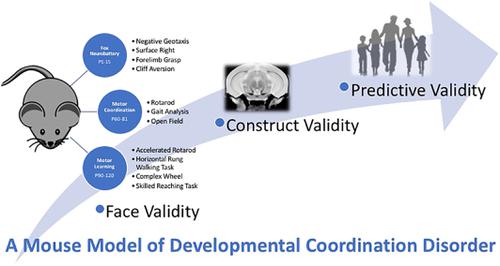当前位置:
X-MOL 学术
›
Genes Brain Behav.
›
论文详情
Our official English website, www.x-mol.net, welcomes your
feedback! (Note: you will need to create a separate account there.)
Using a mouse model to gain insights into developmental coordination disorder.
Genes, Brain and Behavior ( IF 2.4 ) Pub Date : 2020-03-04 , DOI: 10.1111/gbb.12647 Kamaldeep K Gill 1, 2 , Jeffy Rajan Soundara Rajan 3, 4 , Daniel Goldowitz 2, 3, 4 , Jill G Zwicker 2, 5, 6, 7
Genes, Brain and Behavior ( IF 2.4 ) Pub Date : 2020-03-04 , DOI: 10.1111/gbb.12647 Kamaldeep K Gill 1, 2 , Jeffy Rajan Soundara Rajan 3, 4 , Daniel Goldowitz 2, 3, 4 , Jill G Zwicker 2, 5, 6, 7
Affiliation

|
Motor impairments are a common feature of many neurodevelopmental disorders; in fact, over 50% of children with Attentional Deficit Hyperactivity Disorder or Autism Spectrum Disorder may have a co-occurring diagnosis of developmental coordination disorder (DCD). DCD is a neurodevelopmental disorder of unknown etiology that affects motor coordination and learning, significantly impacting a child's ability to carry out everyday activities. Animal models play an important role in scientific investigation of behaviour and the mechanisms and processes that are involved in control of motor actions. The purpose of this paper is to present an approach in the mouse directed to gain behavioral and genetic insights into DCD that is designed with high face validity, construct validity and predictive validity. Pre-clinical and clinical expertise is used to establish a set of scientific criteria that the model will meet in order to investigate the potential underlying causes of DCD.
中文翻译:

使用鼠标模型来了解发育协调障碍。
运动障碍是许多神经发育障碍的共同特征。实际上,超过50%的儿童患有注意力缺陷多动障碍或自闭症谱系障碍可能会同时出现发展协调障碍(DCD)诊断。DCD是一种病因不明的神经发育障碍,会影响运动协调和学习,严重影响儿童进行日常活动的能力。动物模型在行为研究以及运动控制中所涉及的机制和过程的科学研究中发挥着重要作用。本文的目的是提出一种针对小鼠的方法,旨在获得对DCD的行为和遗传方面的洞察力,该方法具有较高的面部有效性,结构有效性和预测有效性。
更新日期:2020-04-22
中文翻译:

使用鼠标模型来了解发育协调障碍。
运动障碍是许多神经发育障碍的共同特征。实际上,超过50%的儿童患有注意力缺陷多动障碍或自闭症谱系障碍可能会同时出现发展协调障碍(DCD)诊断。DCD是一种病因不明的神经发育障碍,会影响运动协调和学习,严重影响儿童进行日常活动的能力。动物模型在行为研究以及运动控制中所涉及的机制和过程的科学研究中发挥着重要作用。本文的目的是提出一种针对小鼠的方法,旨在获得对DCD的行为和遗传方面的洞察力,该方法具有较高的面部有效性,结构有效性和预测有效性。











































 京公网安备 11010802027423号
京公网安备 11010802027423号